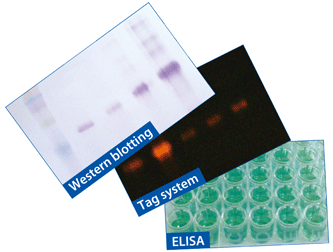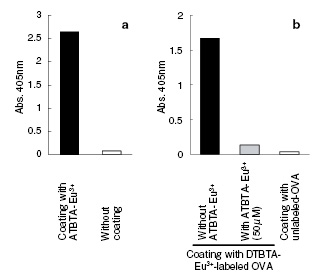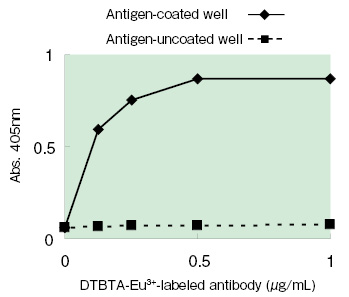[Application]
• With the combination of the antiserum, DTBTA-Eu
3+ is applicable as a tag molecule.
• DTBTA-Eu
3+-labeled molecules can be immunologically detected with ELISA and Western-blotting via the Tag.
About DTBTA-Eu3+ The DTBTA-Eu
3+ is a europium fluorescent labeling reagent, whereas ATBTA-Eu
3+ (TCI code: A2083) is used as a label after conversion to DTBTA-Eu
3+ by reacting with trichlorotriazene. DTBTA-Eu
3+ can be labeled onto proteins and nucleic acids. Different from other lanthanide chelate reagents, the DTBTA-Eu
3+ complex has a high stability constant, and therefore, the problem of fluorescence intensity change in various bu? ers has been greatly reduced. DTBTA-Eu
3+ also has several advantages such as intensity stability in water for a long period, and the stability against photo-bleaching.
If further detailed information about DTBTA-Eu
3+ is required, please refer to “
Europium Fluorescent Labeling Reagent”.
¦
Typical Procedure ELISA using DTBTA-Eu
3+-labeled antibody We demonstrate the immunological technique to detect an antigen with an antibody labeled with a hapten tag.
The antibody that recognizes a certain protein, was labeled with DTBTA-Eu
3+ and a secondary-antibody (anti-DTBTA-Eu
3+ antibody) binds to the tag molecule (DTBTA-Eu
3+).
Reagents
• Antigen protein (10μg/mL)
• DTBTA-Eu
3+-labeled antigen-specific antibody (1mg/mL): Antigen specific primary antibody, which has been labeled with DTBTA-Eu
3+
• Purified anti DTBTA Eu
3+ antibody: purified anti-DTBTA-Eu
3+ rabbit antiserum with Protein A column
• Alkaline phosphatase-conjugated anti rabbit IgG: commercially available
• 10mM diethanolamine buffer (pH9.5) containing 0.5mM MgCl
2
• Chromogenic substrate: 1 mg/mL pNPP in the diethanolamine buffer
• Stop solution: 0.1M EDTA, pH7.5
• TBS: 25mM Tris-HCl (pH7.2) containing 0.15M NaCl
• TBST: TBS containing 0.05% Tween-20
• Blocking solution: 4% skim milk in TBST
• Antibody diluting solution: 1% skim milk in TBST
Procedure
1. Place antigen protein into a 96-well plate (50μL/well) and incubate for 2 hours at room temperature
2. Remove the antigen solution, add blocking solution (150μL/well) to the wells and incubate for 2 hours at room temperature
3. Wash the wells with 200μL TBST, twice
4. Add purified DTBTA-Eu
3+-labeled antigen-specific antibody , which has been diluted at 1, 0.5, 0.25, and 0.125μg/mL with antibody diluting solution, to the well (100μL/well) and incubate for 1 hour at room temperature
5. Remove the antibody solution and wash the well with TBST, 3-times
6. Add purified anti-DTBTA-Eu
3+ antibody (diluted at 1/1000, 100μL/well) to the wells and incubate for 1 hour at room temperature
7. Remove the antibody solution and wash the well with TBST, 3-times
8. Add alkaline phosphatase-conjugated anti rabbit IgG (100μL/well) to the wells and incubate for 1 hour at room temperature
9. Remove the antibody solution and wash the well with TBST, 3-times and further wash with 10mM diethanolamine buffer (pH9.5) containing 0.5mM MgCl
2
10. Add the chromogenic substrate (100μL/well) to the wells and add stop solution (100 μL/well) after the incubation for 5-20 minutes at room temperature
11. Determine absorbance at 405nm






